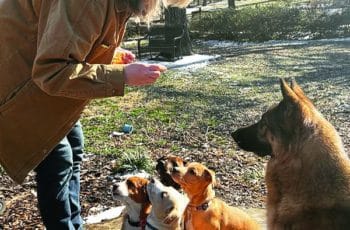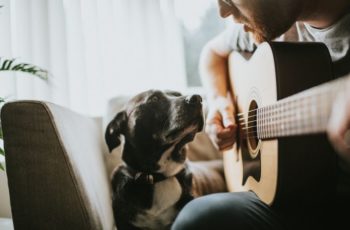by Janice Jones |Last Updated 06-01-2023
The
Lhasa Apso is a small and sassy non-sporting breed with a big diva personality
in a small dog.
Lhasas are adorable, sweet and popular, and they can be
considered the “Supermodel dog” because of their amazing coat of hair that is
parted perfectly down the middle of their back.
Their hair usually covers their
entire body, which is longer than it is tall. Lhasas have gorgeous and dark
features that are highlighted by their light golden coat of hair, and are very
lively and intelligent.
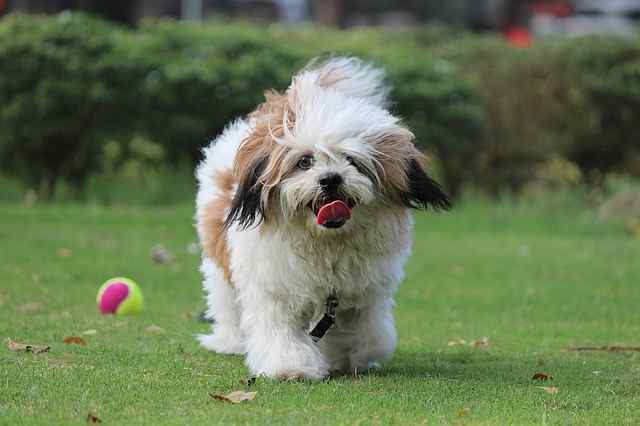 Lhasa Apso: Fun, Curious, Devoted, Affectionate
Lhasa Apso: Fun, Curious, Devoted, AffectionateThe Lhasa Apso – Small Dog Place Video
They also have a unique tail that is long, curly, and
winding. The tail curls over the back adding a “cute factor” to this overall
adorable dog’s appearance. Some Lhasa tails have a kink in them, which most
Lhasas do not possess.
It is said that if your Lhasa has a kink in their tail then
they are considered good luck.
The
Lhasa, along like most dogs, needs its exercise, but is not a breed that
heavily depends on it.
If you forget to take your Lhasa on a walk one day, it
will not complain, and will probably be as content as ever; however, they still
need a small amount of regular exercise.
This makes the Lhasa the perfect dog
for elderly people.
They are perfect for city living and condo living; however,
they are very adaptable and can live pretty much anywhere.
One interesting quality
of the Lhasa Apso is that they are extraordinarily healthy dogs and can live
well into their twenties. The oldest recorded Lhasa lived to be a whopping 29
years old.
The Lhasa absolutely
adore their families and owners and will stay very loyal to them with the
appropriate attention and loving.
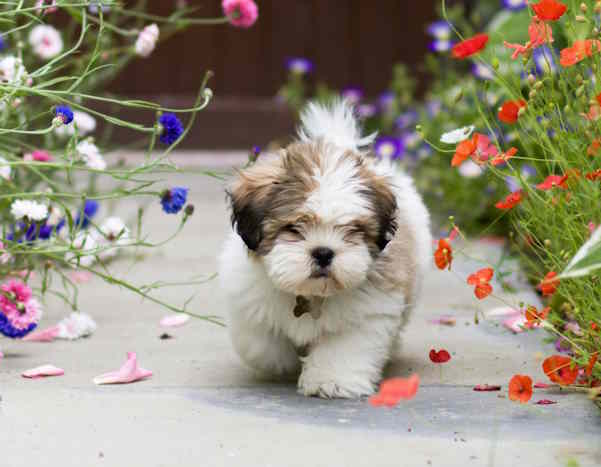
Quick Facts:
Other Names Used: Jelly Bean dog (due to the
variety of colors), originally named Apso Seng Kye in Tibet
Affiliation: Non-Sporting group; AKC
recognized in 1935
Size
Height: 10-11 inches, a little less for
females
Weight: 13-15 lbs
Coat Type: Coarse, heavy, and long double
coat
Colors: Black, Black and Tan, Cream, Golden, Grizzle, Red, Red Gold, White, Blue, Charcoal, Gray, Liver, Silver (AKC Standard)
Country of Origin: China, more specifically, the
Himalayan mountains in Tibet
Activity Level: Low
Life Expectancy: 15 years or more, many live well
into their twenties
Good with Children: with supervision and responsible
children, yes
Good with Other Pets: yes
At a Glance: The Lhasa Apso
Explanations for At a Glance Ratings
- Playfulness: Most=5 Less=1
- Affection: Most=5 Least=1
- Friendliness Towards Strangers: Most=5 Least=1
- Good with Children: Good=5 Not Good=1
- Good with Other Dogs: Good=5 Not Good=1
- Good for First Time Owners: Good=5 Not Good=1
- Amount of Exercise Required: Much=5 Minimal=1
- Ease of Training: Easy=5 Difficult=1
- Watch Dog Ability: Excellent=5 Poor=1
- Grooming Needs: Extensive=5 Minimal=1
- Shedding: Heavy Shedding=5 Minimal Shedding=1
- Cold Tolerance: Cold Well Tolerated=5 Poorly Tolerated=1
- Heat Tolerance: Heat Well Tolerated=5 Poorly Tolerated=1
History of this Small Dog
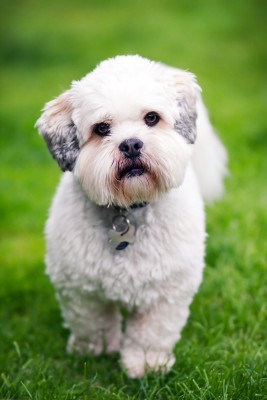 Lhasa Apso in a Puppy Cut
Lhasa Apso in a Puppy CutThe
Lhasa Apso is an ancient breed originated in the Himalayans. For centuries,
they were confined only to Tibet where holy men and nobles kept them in
isolation where they performed as watchdogs.
In Tibet, they called them “Apso
Seng Kye” which directly translated to “bark lion sentinel dog.” In the 1930s,
the Lhasa made it to the United States after being given to the US by the 13th
Dalai Lama.
Named after the sacred city Lhasa, the Lhasa Apso was considered
sacred. Thanks to C. Suydam Cutting, the breed was spread to other parts of the
world as well by introducing the Lhasa to the U.S as a gift from the Dalai
Lama. The first of the breed was introduced in Britain in the 1920s, and
America in the 1930s.
Recent
studies have shown the Lhasa Apso is one of the breeds that are most closely
related to the ancestral wolf. In Tibet, Lhasas were never sold as adults and
they only way someone could get one was as a puppy.
Since these dogs were so
sacred, they were very expensive and particularly hard to get possession of.
Lhasas were used to warn the residents of Tibetan nobility and Buddhist
monasteries if the intruder happened to sneak past the external guards. Lhasas
were very good at their jobs and earned high credibility because of it.
When
this breed first came to America, they were referred to as Lhasa Terriers
instead of the modern and more common name Lhasa Apso.
The Lhasa has been
identified as one of the 14 most ancient of all dog breeds. This suggests that humans first began
breeding dogs because they wanted a companion that would also warm their
laps.
They were first accepted by the American Kennel Club in
1935 and now rank 65th in popularity among all of the AKC recognized
breeds.
Personality/Temperament
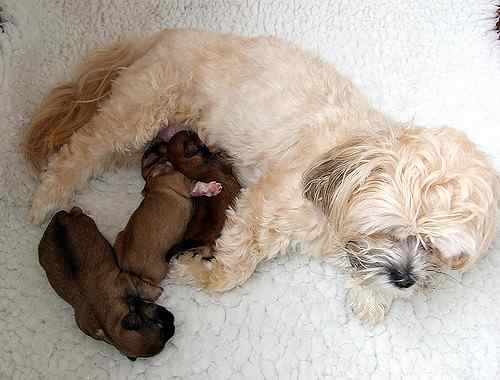
Photo Source
This particular breed is very loyal to those close to them, but is very wary of
strangers, which is why they make such effective watchdogs.
Lhasas can also be
very hard headed and are prone to Small Dog Syndrome. That is a condition in
which the dog seems to think that they are the alpha dog and that the human
should listen to them.
They tend to be snappy, anxious, and act out; however,
these are NOT traditionally traits of the Lhasa Apso.
Small Dog Syndrome is
human induced and is the cause of irresponsible owners. As hard as it will be
to give in to the Lhasas cute and adorable face, there has to be an alpha in
the relationship, and that is you.
If you train and raise your pup right, they
are adorable, friendly, sweet, and affectionate with a complete different character
to those who are improperly raised.
Lhasas
are also very adaptable and can live pretty much anywhere; however, they are
perfect for city living and condo living because they do not require an
excessive amount of exercise.
This also makes Lhasas good for families that are
less active. This breed responds well to motivational training, and because of
their tendency to be more on the stubborn side, it is a good idea to start
training early.
Overall, the Lhasa Apso is a very loving, friendly dog, and
with proper care and training is not only a pet, but also a best friend.
Grooming this Small Dog
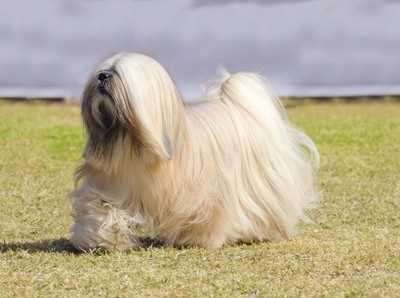 Lhasa in a Full Show Coat
Lhasa in a Full Show CoatThe
Lhasa Apso is not the type of breed that one can just brush and comb every once
in a while, and everything will be fine. They need regular visits to the
groomers, especially if one is looking to show them.
Typical Lhasas that are
being shown have the long, silky hair that goes to the floor. This hair needs
extra care, and even more regular visits to the groomer than your average pet
might need.
Grooming can be a lot of work, but usually most owners keep their
Lhasa in a puppy cut. An advantage to this breed is that they do not shed much,
making them ideal for those who struggle with allergies.
While you might not see much of their hair on you or your furniture, the dead hairs need to go somewhere. Low shedding dogs tend to shed their hair into coat. Lhasas have a thick
double coat that continues to grow and can tend to mat if not brushed daily.
First brushing with a pin or slicker brush, followed by a combing with a steel comb will assure that you have gotten down to the skin and removed all tangles and knots. Just a soft brushing over the top coat will leave mats in the soft undercoat which will continue to get larger if not removed.
The pads of the feet
also need to be checked as well as around the eyes and ears. Hair tends to grow
excessively in their ears, which could lead to ear infections.
If you plan to get your Lhasa’s coat professionally groomed, the groomer will clip the hair between the foot pads and remove any hair in the ear canal. If you do the grooming for your pet yourself, then you will need to add those tasks to your grooming routine.
There are different options for the hair on the head. Some people who want the long look will pull it up into a single top knot (as seen in the Shih Tzu breed) or enjoy pulling the hair into two pony tales.
Typically, Lhasas are shown without the elaborate top knots seen in some breeds.
In addition to the special grooming needs of the Lhasa, they also need to have their nails clipped about every couple of weeks and ideally their teeth should be brushed daily.
Regularly
grooming and brushing will leave your pups hair in perfect and beautiful
condition.
Health Concerns
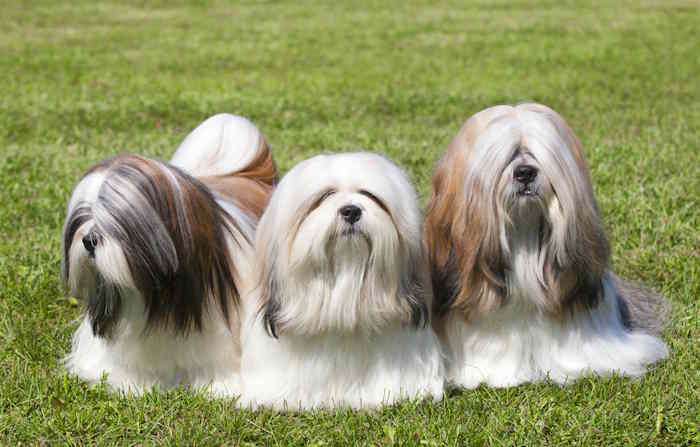
Lhasas are
in general, very healthy dogs that can live to an upward of 20 years, although the average life span is 12 to 15 years.. They are
prone to ear infections due to the hair growing excessively, but other than
that they are in well condition.
There are a few health concerns to keep your
eye out for, but other than that you have a healthy dog on your hands.
Hip Dysplasia
This is an orthopedic disorder where the ball of the hip does not fit snugly into the hip socket resulting in lameness and arthritis.
Read about Hip Dysplasia
Pigmentary Keratitis
In long haired breeds where the hair continues to grow, hair around the head and face can irritate the eyes. When the hair is pulled up and away from the eyes, this normally does not occur.
But when shorter hairs begin to touch the eye they can irritate the cornea which is normally transparent.
Over time, irritation from hair and even injuries, wind, smoke, dust or allergies can cause the cornea to become cloudy and ulcerated. Eventually the cornea appears darker.
The color change will not cause pain, but some of the underlying problems can and will also eventually lead to blindness.
This is common in brachycephalic dogs especially those that have prominent eyes that are easily exposed to injury.
Cherry Eye
Cherry Eye occurs when the gland, also known as the third eyelid swells. It appears as a red growth thus the name in the inner corner of the eye. Surgery will take care of the problem
Read about Cherry Eye
Patellar Luxation
This is an extremely common ailment in small breed dogs where the knee cap slides in and out of place. Patella is the name for knee and luxation means dislocation. Dogs can become lame or live normally depending on the severity of the dislocation.
Read about Patellar Luxation
Renal Dysplasia
An abnormal or under-developed kidney that often results in death. There is a DNA test for the Lhasa that breeders should use prior to using them in their program. Owners can also have their dogs tested to find out if the dog has or doesn’t have the disease or is a carrier.
Sebaceous Adentitis (SA)
This is a skin condition with genetic roots. When this ailment is present, the sebaceous glands in the skin become inflamed and then destroyed. Symptoms include dry scaly skin with hair loss usually at the top of the head, neck and back. If the condition is severe, the dog may have an usually unpleasant odor and the skin seem thick. Secondary infections are common and may cause discomfort in the dog.
Progressive Retinal Atrophy (PRA)
This group of eye diseases eventually causes the retina of the eye to deteriorate. The dog first develops night blindness and the eventually they lose their sight altogether. Blindness is never a good thing, but dogs can adjust and live fairly normal lives without this sense.
Read about Progressive Retinal Atrophy
Pros and Cons of Lhasa Apso Dog Ownership
Pros
- Non
shedding - Minimum
exercise - Good
watchdogs - Adaptable
- Small,
but not yappy - Healthy,
and long living
Cons
- They
need excessive grooming - Can
suffer from Small Dog Syndrome if not brought up right - Stubborn
- Unpredictable
actions around strangers
 Lhasa Apso Breed Information
Lhasa Apso Breed InformationFun Fact
Lhasa Apso have appeared in at least two episodes of The
Simpsons.
Resources
Breed Club:
American Lhasa Apso Club, Inc.
Similar Breeds
Conclusion – Is the Lhasa Apso the Right Breed for You?
The Lhasa Apso is a unique and loving breed of dog that makes an excellent companion for families and individuals alike.
However, they do require a certain level of care and attention, so it is important to be prepared before bringing one into your home.
If you are willing to put in the time and effort to care for a Lhasa Apso, they will reward you with years of love and companionship.
If you are considering getting a Lhasa Apso, do your research and find a reputable breeder or rescue organization.
These dogs require a certain level of care and attention, but they are well worth the effort. With proper training, socialization, and care, a Lhasa Apso can be a loyal and loving companion for many years to come.
Already own one of these Dogs? Breed these Dogs, Know About this Breed? Please Share
We’d love to hear your thoughts about this Breeed.
What Other Visitors Have Said
Click below to see contributions from other visitors to this page…
Reference and Further Reading
We at Small Dog Place always recommend that you do as much reading about the dog you might like to purchase or adopt before the big day. Here are some books that we have found helpful and hope you will too.
Does This Article Deserve Your Thumbs Up?
We always appreciate your support and encouragement. Your thumbs up means so much to us. Please like this article.
If you find this page or any page on Small Dog Place Helpful, or Useful in anyway, I’d love it if you would click the small heart found on the bottom right of each page.
You can also share or bookmark this page — just click on the:

Free Monthly Newsletter
Sign Up for Our Free Newsletter and get our Free Gift to You.
my E-book, The Top 10 Mistakes People Make When Choosing a Dog (and how to avoid them)

